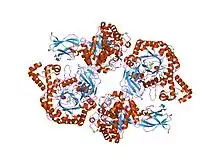Glycoside hydrolase family 14
In molecular biology, Glycoside hydrolase family 14 is a family of glycoside hydrolases.
| Glycosyl hydrolase family 14 | |||||||||
|---|---|---|---|---|---|---|---|---|---|
 beta-amylase from bacillus cereus var. mycoides in complex with maltose | |||||||||
| Identifiers | |||||||||
| Symbol | Glyco_hydro_14 | ||||||||
| Pfam | PF01373 | ||||||||
| Pfam clan | CL0058 | ||||||||
| InterPro | IPR001554 | ||||||||
| SCOP2 | 1byb / SCOPe / SUPFAM | ||||||||
| CAZy | GH14 | ||||||||
| |||||||||
Glycoside hydrolases EC 3.2.1. are a widespread group of enzymes that hydrolyse the glycosidic bond between two or more carbohydrates, or between a carbohydrate and a non-carbohydrate moiety. A classification system for glycoside hydrolases, based on sequence similarity, has led to the definition of >100 different families.[1][2][3] This classification is available on the CAZy web site,[4][5] and also discussed at CAZypedia, an online encyclopedia of carbohydrate active enzymes.[6][7]
Glycoside hydrolase family 14 CAZY GH_14 comprises enzymes with only one known activity; beta-amylase (EC 3.2.1.2). A Glu residue has been proposed as a catalytic residue, but it is not known if it is the nucleophile or the proton donor. Beta-amylase[8][9] is an enzyme that hydrolyzes 1,4-alpha-glucosidic linkages in starch-type polysaccharide substrates so as to remove successive maltose units from the non-reducing ends of the chains. Beta-amylase is present in certain bacteria as well as in plants.
Three highly conserved sequence regions are found in all known beta-amylases. The first of these regions is located in the N-terminal section of the enzymes and contains an aspartate which is known[10] to be involved in the catalytic mechanism. The second, located in a more central location, is centred on a glutamate which is also involved[11] in the catalytic mechanism.
The 3D structure of a complex of soybean beta-amylase with an inhibitor (alpha-cyclodextrin) has been determined to 3.0A resolution by X-ray diffraction.[12] The enzyme folds into large and small domains: the large domain has a (beta alpha)8 super-secondary structural core, while the smaller is formed from two long loops extending from the beta-3 and beta-4 strands of the (beta alpha)8 fold.[12] The interface of the two domains, together with shorter loops from the (beta alpha)8 core, form a deep cleft, in which the inhibitor binds.[12] Two maltose molecules also bind in the cleft, one sharing a binding site with alpha-cyclodextrin, and the other sitting more deeply in the cleft.[12]
References
- Henrissat B, Callebaut I, Fabrega S, Lehn P, Mornon JP, Davies G (July 1995). "Conserved catalytic machinery and the prediction of a common fold for several families of glycosyl hydrolases". Proceedings of the National Academy of Sciences of the United States of America. 92 (15): 7090–4. Bibcode:1995PNAS...92.7090H. doi:10.1073/pnas.92.15.7090. PMC 41477. PMID 7624375.
- Davies G, Henrissat B (September 1995). "Structures and mechanisms of glycosyl hydrolases". Structure. 3 (9): 853–9. doi:10.1016/S0969-2126(01)00220-9. PMID 8535779.
- Henrissat B, Bairoch A (June 1996). "Updating the sequence-based classification of glycosyl hydrolases". The Biochemical Journal. 316 (Pt 2): 695–6. doi:10.1042/bj3160695. PMC 1217404. PMID 8687420.
- "Home". CAZy.org. Retrieved 2018-03-06.
- Lombard V, Golaconda Ramulu H, Drula E, Coutinho PM, Henrissat B (January 2014). "The carbohydrate-active enzymes database (CAZy) in 2013". Nucleic Acids Research. 42 (Database issue): D490-5. doi:10.1093/nar/gkt1178. PMC 3965031. PMID 24270786.
- "Glycoside Hydrolase Family 14". CAZypedia.org. Retrieved 2018-03-06.
- CAZypedia Consortium (December 2018). "Ten years of CAZypedia: a living encyclopedia of carbohydrate-active enzymes" (PDF). Glycobiology. 28 (1): 3–8. doi:10.1093/glycob/cwx089. PMID 29040563.
- Mikami B, Morita Y, Fukazawa C (March 1988). "[Primary structure and function of beta-amylase]". Seikagaku. The Journal of Japanese Biochemical Society. 60 (3): 211–6. PMID 2457058.
- Friedberg F, Rhodes C (1988). "Segments of amino acid sequence similarity in beta-amylases". Protein Sequences & Data Analysis. 1 (6): 499–501. PMID 2464171.
- Nitta Y, Isoda Y, Toda H, Sakiyama F (April 1989). "Identification of glutamic acid 186 affinity-labeled by 2,3-epoxypropyl alpha-D-glucopyranoside in soybean beta-amylase". Journal of Biochemistry. 105 (4): 573–6. doi:10.1093/oxfordjournals.jbchem.a122706. PMID 2474529.
- Totsuka A, Nong VH, Kadokawa H, Kim CS, Itoh Y, Fukazawa C (April 1994). "Residues essential for catalytic activity of soybean beta-amylase". European Journal of Biochemistry. 221 (2): 649–54. doi:10.1111/j.1432-1033.1994.tb18777.x. PMID 8174545.
- Mikami B, Sato M, Shibata T, Hirose M, Aibara S, Katsube Y, Morita Y (October 1992). "Three-dimensional structure of soybean beta-amylase determined at 3.0 A resolution: preliminary chain tracing of the complex with alpha-cyclodextrin". Journal of Biochemistry. 112 (4): 541–6. doi:10.1093/oxfordjournals.jbchem.a123935. PMID 1491009.